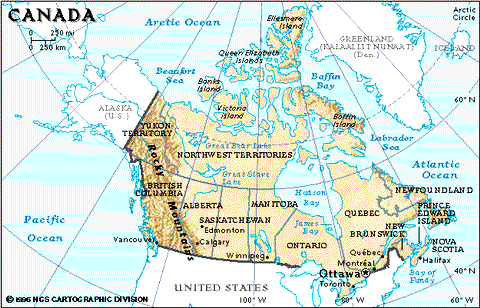

|
![]() CANADA AREA: 9,970,610 sq km (3,849,670 sq
mi). POPULATION: 29,561,000. CAPITAL: Ottawa, pop. 314,000
(920,900). RELIGION: Roman Catholic, Protestant. LANGUAGE:
English, French. LITERACY: 99%. LIFE EXPECTANCY: 78 years.
ECONOMY: Industry: transportation equipment, food processing,
refined-fuel products, paper products, chemical products, primary
metals. Agriculture: wheat, seafood, livestock, dairy products,
poultry. PCI: $20,670.
CANADA AREA: 9,970,610 sq km (3,849,670 sq
mi). POPULATION: 29,561,000. CAPITAL: Ottawa, pop. 314,000
(920,900). RELIGION: Roman Catholic, Protestant. LANGUAGE:
English, French. LITERACY: 99%. LIFE EXPECTANCY: 78 years.
ECONOMY: Industry: transportation equipment, food processing,
refined-fuel products, paper products, chemical products, primary
metals. Agriculture: wheat, seafood, livestock, dairy products,
poultry. PCI: $20,670.
 |
This second largest of all nations, framed by the world's longest coastline, is one of the least densely inhabited and most prosperous. France pioneered settlement, but Britain gained control in 1763. In 1867 the British North America Act united English-speaking Upper Canada (Ontario) and French-speaking Lower Canada (Quebec) with Nova Scotia and New Brunswick in a self-governing confederation. Passage of the Canada Act of 1982 enabled the ten provinces and two territories to enact an amended constitution, which predominantly French Quebec has refused to sign. To ensure the survival of the entire confederation, constitutional reforms have been proposed, which not only define Quebec as a ``distinct society'' but also establish a popularly elected senate and recognize the rights of aboriginal peoples to self-government. Text source: National Geographic Atlas of the World Revised Sixth Edition, 1995 |
|
| Map of Ontario | |